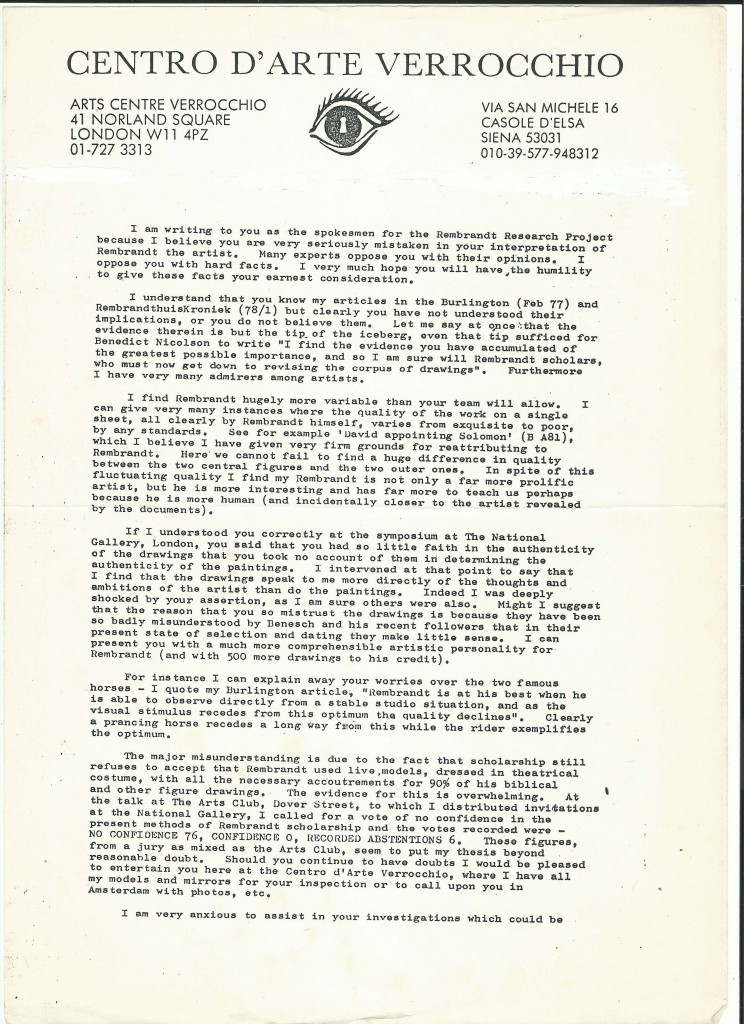My encounter with Prof. Ernst van der Wetering, heavy weight champion of the Rembrandt world, was over all to quickly. See my blog www.verrocchio.co.uk/blog TRIUMPH OF TRUTH. Though the discussion was all on his territory (the two Adoration paintings) he did not even seem to understand the difference between a cartoon reversal and a mirror image and therefore was unable to understand his crushing defeat. (A mirror reverses a different view of the same group one observes direct. It therefore proves the presence of a three dimensional group for Rembrandt and his students to observe; the student versions prove the same.)
If there is another heavy-weight out there who thinks he could do better than Van der Wetering I am very willing to have a return match in front of a primed audience containing a fair smattering of people who can think three dimensionally, such as artists, engineers or architects. My fees would not reflect the fact that I am now the reigning champion, though naturally I do not want to end up out of pocket.
SERIOUSLY, Rembrandt scholarship has been in a disastrous state for too long. The scholars will never willingly concede defeat. I have been criticizing from the side-lines for 43 years without effect. The public or the media will have to intervene to arrange this confrontation before I go the way of all flesh. (I am now 87)
I have wonderful news to give the world if I could get a word in edgeways. I am in the process of revising my 1978 book on Rembrandt which was accepted by Phaidon and then rejected after a heinous reader’s report from an anonymous Rembrandt expert. Is there a brave publisher out there?
This is an attempt to show how my discoveries should alter our assessment of Rembrandt’s character and the extent of his corpus in major ways. I accept what his contemporaries said about Rembrandt, the scholars pursue their post-photography ideal of ‘invention’ as the prime quality of art. Rembrandt ‘produced’ his tableaux vivent to work from but he put his chief creative effort into observing the expression of feeling in his drawing, which of course involved memory of his life’s experience. Groups of life models cannot maintain expression for the time the artist needs to complete a drawing. He presumably posed his models with care but he then interprets their inner thoughts brilliantly relying on memories of experience.
Truly horrid things have been said about Rembrandt in the press as a result of recent scholarship. For instance in the New York Herald Tribune. “Rembrandt was a money-changer in the temple of art”, followed by a whole paragraph of hostility. In the same year 1991, when the 3 major exhibitions were taking place to establish the new scholarship he was compared more often with Andy Warhol in the press than with any other artist, for his business procedures based on the erroneous idea that he ran a huge workshop churning out his recently dismissed works, signing them and selling them as his own. In fact though such practices were normal in Rembrandt’s time, he was determined to paint every stroke himself. The experts can find no other hand but Rembrandt’s in “The Night Watch”. After that success he fell from favour in the market-place so there was no temptation to do otherwise with later works. Rembrandt ran an art school not a workshop.
The whole idea of Rembrandt’s Workshop is a recent invention, you will find no reference to it before 1968 when the RRP started work, its a fabrication. Rubens had a workshop of a few very gifted assistants because he was catering for the whole Catholic world in a post Reformation crisis. He was amazingly gifted and with an enormous market gasping for his painting. Rembrandt, a contemporary, was the other side of the coin altogether. He would have loved to be in Rubens’ position but the protestants had no use for “idols”, they were busy breaking them up. He sold more self-portraits than religious subjects but his ambition to be a history painter and his special gift for seeing how we humans express ourselves physically could not be denied. The Bible was his main source of inspiration throughout his life. But I guess when the “experts” finally revise their ideas about the dates of his drawings, fewer group subjects will be found after his peak popularity c.1642. Before that he had access to many models and many students to help pay for them.
Rembrandt himself rarely if ever painted still life or landscape though he made many beautiful drawings of the landscape around Amsterdam. Otherwise, his painted landscapes were nearly always just as a background for human subjects. On the one occasion when he was asked for a landscape he had only a student’s example in stock and he answered the request in a straightforward manner saying “with a few touches from me it could pass for a Rembrandt”. The idea that he would accept student work on his own is outrageously far fetched.
I have shown how mistaken is the designation of his reworking of his own drawing of Job and his Comforters as a student work corrected by Rembrandt, downgrades a drawing which can teach us much and correct our assessment of his character. Link
I believe in over 2000 drawings by Rembrandt. The specialists vary but have recently reduced his output drastically; for instance Otto Benesch’s catalogue of 1954 contained nearly 1500 but today’s scholars – P.Schatborn (recently of the Rijksmuseum) believes in only 500, Professor Slive emeritus of Harvard believes in c.800. How is it possible that these experts vary so widely?
The answer is very simple, the establishment experts believe that stylistic analysis is scientific. I believe that stylistic analysis is hugely mistaken. It is true that in handwriting one can recognise the person whose writing; writers are working with letters which they have used thousands of times and it doesn’t matter truly whether they are using a pencil, a ball pen or a nib the way they would form a letter will always be more or less the same. Writing music Mozart wrote semiquavers in a way that is different from Beethoven’s and recognisably different. Unfortunately with art it doesn’t work the same way. Perhaps we are always drawing hands but all hands are different, they may all have five fingers but seen from different points of view they vary enormously, also according to the age of the subject and so on. Van Dyck was famous for his hands Illust.1. they are always very aristocratic. long fingers, very elegant and always more or less the same. Probably not one in a hundred aristocrats had hands resembling these but most would have wishes for them and would pay well for receiving their attribution.
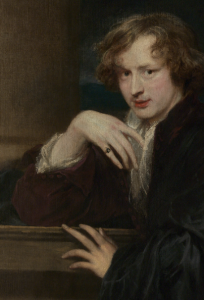
Van Dyke Hands
Rembrandt, however, is famous for the breadth and precision of his responses. His hands are incredibly different from one another; they vary not only with the age of his models but with the instruments he uses which will deposit more or less ink as he draws on papers with varying absorbencies. Naturally the marks made are different and the shapes wonderfully varied according to what he is observing at the time.(hand of plait 2), If the subject was momentary, the hands suffer.(naughty boy 3)
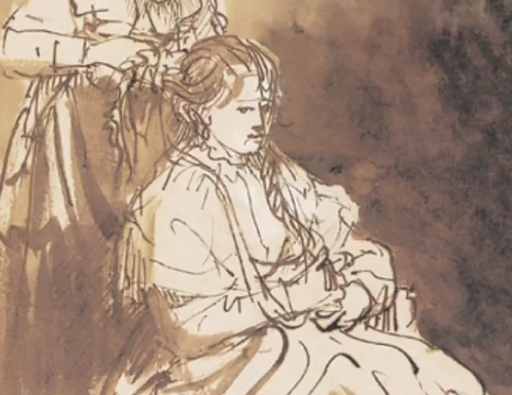
Here the hands holding the plait are Rembrandt at his very best, so specific and unique.
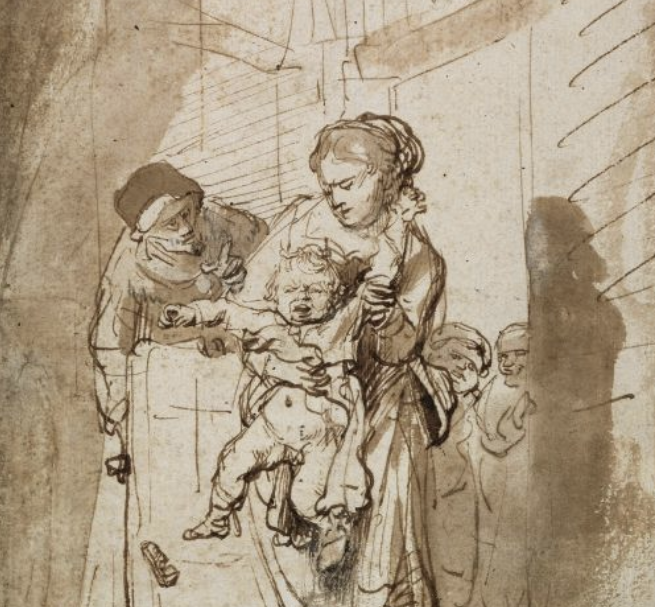
Rembrandt - naughty boy. The pose is wonderful but the hands minimal.
Artists tend to admire the variety of his responses and tend to be bored by Van Dyke’s stereotypes while still admiring their elegance. Rembrandt has suffered enormous loss in the last 50 years because the experts want Rembrandt to be consistent; he was not. His contemporaries all tell us how unreliable he was and his etchings demonstrate the truth of this. But the writer of the catalogue, Otto Benesch claims he could date a Rembrandt drawing by style to within 1 or 2 years, 3 at most. The marketplace is impressed by this boast. I am appalled; in fact I have proved beyond reasonable doubt that Benesh’s method of dating drawings is completely at odds with the facts. As the advertisement for my talk at the Wallace Collection states “Konstam’s discoveries have proved surprisingly controversial considering that they agree entirely with the documentary evidence of of Rembrandt’s own contemporaries and earlier connoisseurship. They are clear and obvious to the layman observer. It is today’s scholars that are out of step.”
I have shown how Rembrandt responds to the different stimulus he is working from. If he is working from life under his control he can take his time and sometimes draws hands unbelievably skilfully. (Hagar4).
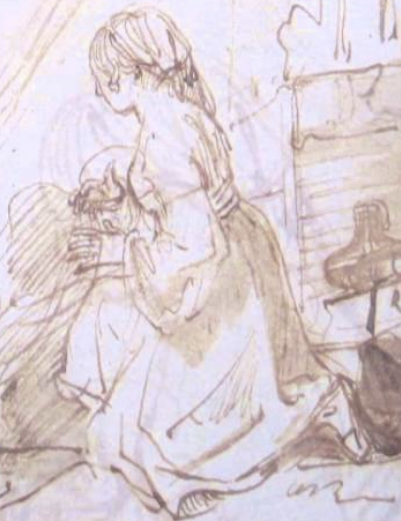
Hagar meets the Angel - beautifully drawn hands
Sometimes life in the street. The Pancake maker is not under his control so his hands become pretty wild.
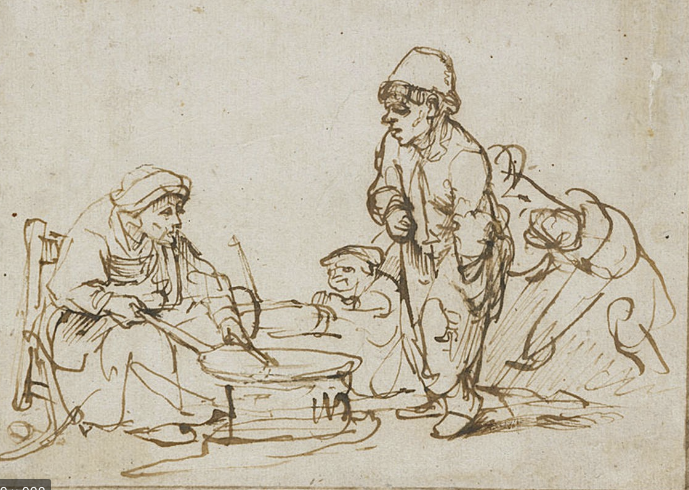
Street vendor - Pancake maker
If he’s drawing from a mirror (hand from mirror image 6)
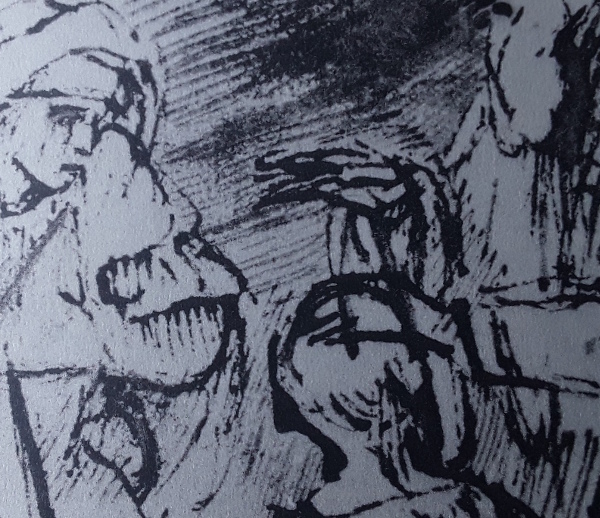
Abraham's hands observed in a mirror
which he has done at least 100 times in my estimation we can expect the result to be a great deal less interesting than when he is responding to life directly. All this is common sense, it should not surprise us. But the marketplace would like Rembrandt to be reliable, in truth the quality of his drawing is more varied than any other great artist I can think of – as demonstrated here.
The experts think he was drawing out of his head almost all the time. I know that he was drawing from life whenever possible. His contemporaries tell us “he would not attempt a single brushstroke without a living model before his eyes” that could hardly be clearer. Why have the experts decided the opposite? When he didn’t have life in front of him his imagined drawings are very different and inferior (see Jupiter with Philemon and Baucis 8 whole). The worst drawing certainly by Rembrandt because his writing on the drawing tells us the story that the drawing itself fails to convey..
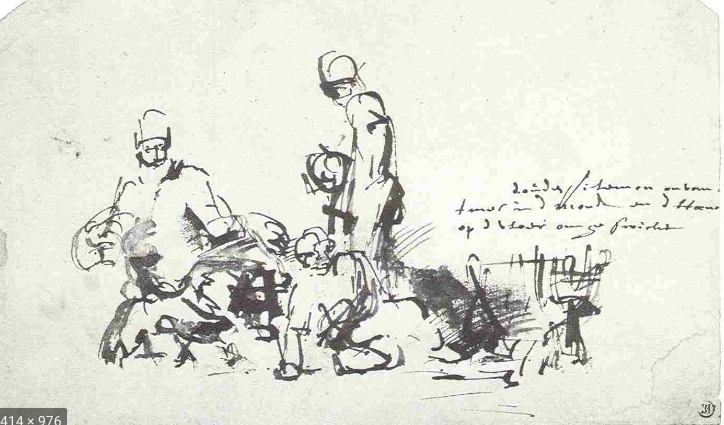
Jupiter with Philemon and Baucis
When he had life in front of him his results also varied enormously and unlike Michelangelo he didn’t seem to mind leaving behind some very inferior drawings for us to puzzle over. Rembrandt varies from exquisite to quite banal or careless as a draftsman; that is why I can believe he produced very many drawings of which over 2000 still exist today. We know he had students who drew from the same reality he set up to work from himself but fortunately none of his students drew remotely like him; some of them were reasonable draughtsman, none of them approaching greatness.The confusion is of the scholars making. The trouble is the experts recognise excellence in Florentine Renaissance art and are disappointed in Rembrandt’s genius because it is not the same. Where the Florentines were great at the nude physique Rembrandt is interested primarily in what is going on in the head/heart of his subjects. I cannot agree with Houbraken that “his female nudes were such pitiful things that they are hardly worth mentioning” but I can easily understand why he said it. I therefore question the recent de-attribution of a few mediocre drawings which are clearly of Rembrandt’s mistress Hendrijke, one of which is a preliminary study for a famous etching! The Arrow Holder.
My method of assigning drawings to Rembrandt relies on identifying his style of form making that is based on three dimensional geometry derived from Rome rather than from the Florentine method, Greece.. I don’t care if he makes a blot or a mess in his drawing of “The Deathbed of David”
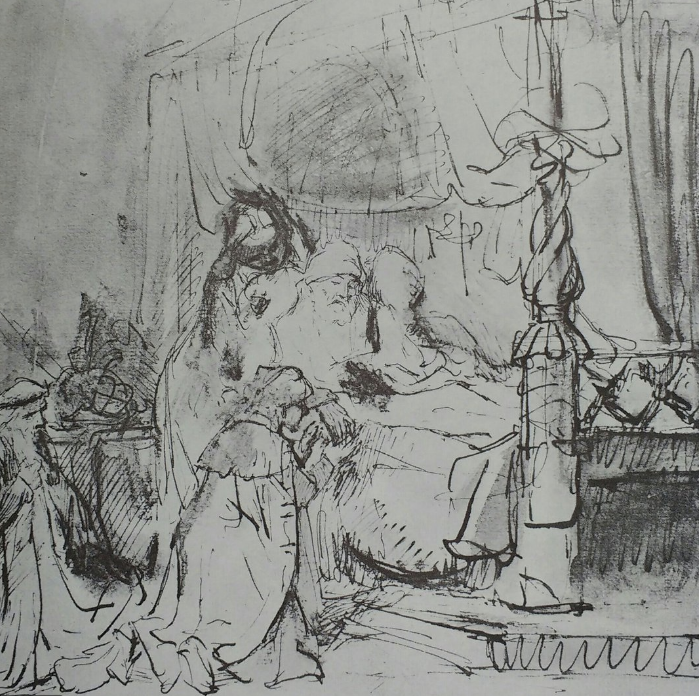
Deathbed of David
because two-thirds of the drawing is so superb as illustration and typical in form it could not possibly be by one of his students, nor for that matter by Van Dyck. Only very rarely am I in doubt as to whether a drawing is by Rembrandt or by someone else because his work, good or bad, is on a different plane all together. By accepting as justified the critical descriptions of Rembrandt’s work by his contemporaries I have no difficulty in accepting some mediocre drawings by him (see Harsh Criticisms below).. Our experts alas, see the faults but do not seem responsive to his genius. They have little understanding of his style and less of his character or enthusiasms, they regard the mention of human interest as ‘unscientific’. No wonder they have missed Rembrandt to the point of madness. It is pointless to expect Rembrandt to behave like the classical masters. He is the first of the moderns; he was living through the revolution that has created modern science, Rembrandt has changed art in a similar way- by confidence in his own observations rather than in artistic tradition.
Rembrandt spent half his creative energy on a subject matter which from a market point of view was a non-starter in protestant Holland. He painted what he wanted not what the market demanded. We don’t even know to which protestant sect he belonged. He got involved with the Calvinists because Hendrijke, his partner for 17 years, was accused by them of living with Rembrandt in concubinage. He did not show up at her trial, maybe he had become a Mennonite by then. We can surmise that he was a believer of some kind but there are good reasons for him to be involved with Biblical subjects other than belief:
The Bible was the best known book of stories of every kind, read throughout Christendom and beyond. It had recently been translated into most of the languages of Europe from Latin, Greek or Aramaic and so was hot news for most Christians. The sheer richness of the human subject matter was a gold-mine for anyone interested in investigating the human psyche. The only other possibility for the same mining was classical mythology, which he used occasionally. But it did not have the same popular following. Ovid was for the scholarly few.
Rembrandt does not compete with Rubens, Van Dyck or Hals in swiftness of execution; he goes his own way at his own pace, often remarkably slowly. The experts like him to be making bold strokes,often these are a last resort to make clear second or third thoughts.. Rembrandt was a true artist seeing life as truthfully as he could, without embellishment. He is very much a man of his own time insofar as he is following the example of the great scientists who refused to take Aristotle’s word for how the physical world works, they too observed for themselves. That is why many artists regard Rembrandt as the one old master who speaks to us moderns directly. Other old masters we can admire but there is not that feeling that we are in the same business. Rembrandt is the beginning of the modern era in art as Copernicus, Galileo and Newton are in science.
The scholars want him to be the same as the older masters; he is not. They seem to have no idea of his originality. To read recent scholars is to get no guidance as to why the rest of us admire him so much, its as if they need to pigeonhole him and in so doing, rob him of his unique position in art. They are looking with a narrow focus without understanding; they want to know which works are his without any discrimination as to which are better or worse, a distinction of most interest to the rest of us.
I offer a rational explanation for his variability – the scholars seek to explain it by the development of his style. They talk in special jargon to put their folly beyond common sense criticism. Rembrandt relied on observation more than most. He did not believe in invention and made that plain when he was obliged to invent: (flying angel).
***************
Panowski recommended art historians should not fall in love with their subject; reasonable advice but it has been followed to the annihilation of any kind of appreciation. Scholars are afraid of making judgements that will not last. Nothing lasts in man’s restless view but its necessary to make judgements to guide our own present effort. I regard Rembrandt as the most important artist ever and I am fully prepared to tell you why.
Rembrandt was following Caravaggio’s example in a general way, there were several Caravaggists in Holland at the time. In this he was merely following a trend. When he set up studio in his home town of Leyden with his younger but more experienced partner Jan Lievens, he was clearly the junior partner in quality but from those inauspicious beginnings he rose rapidly. He acquired the technical mastery of Lievens and surpassed him in vision in 2 or 3 years. His painting of “Judas Returning the 30 pieces of Silver” was noticed and praised by Huygens as better judgement and taste than Lievens. It is highly dramatic and set Rembrandt on his way towards the expression of human emotion which was to drive his art for the rest of his life. Interestingly it is the first of his paintings that we can recognise immediately as the Rembrandt we know from his subsequent output. His earlier work is quite different and amazingly inferior.
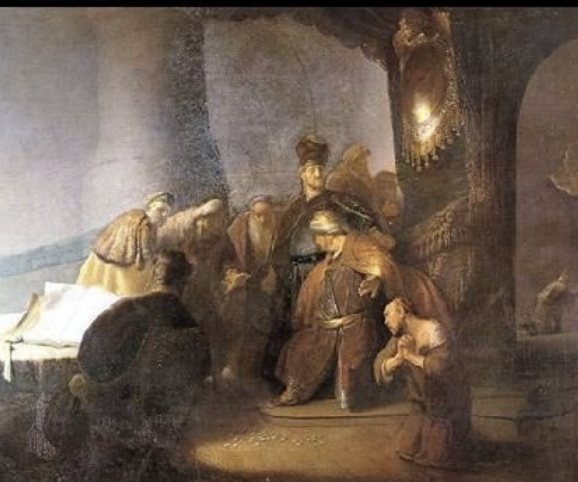
Judas returning the 30 Pieces of Silver
I am going to describe Rembrandt’s originality in somewhat different terms to the usual praise of his mastery of light or his broad brushwork which are admirable but not crucial. Rembrandt bought and studied no fewer than 30 Roman portraits. They were much sort after and therefore very expensive. He filled two books of studies of them. Kenneth Clark finds him lacking in taste in doing so because Roman work has been consistently disparaged by art historians since Winckelmann. This is a huge mistake in my view; half the artists of Europe use the three dimensional geometry found in Roman portraits as the form base of their work: Masaccio, Mantegna, Holbein, Rembrandt, Degas and Van Gogh to name but a few. Most use it as the method of suggesting the three dimensional nature of solid objects, Rembrandt went further and used it to define the space between his protagonists as well. By this means coupled with observation from live groups, he has a control over space relationships which is uniquely precise. It is the way in which he conveys drama or psychological relationships; his particular gift.
Normally artists use pespective to define space, and if you are constructing space this is the only way. But Rembrandt was observing space from tableaux vivent he set up for himself and his students to work from. The creation of the tableaux was an important part of his art. His student Hoogstraten tells us as much, yet the experts think its more exciting if artists imagine it all. Alas, artists never make so good a job of intimate space by construction as Rembrandt did from observation. It is another of his original insights that space needs to be observed. I am sure he would not have described it that way himself, consciousness of space perception is a recent 20th Century notion but Rembrandt was the the greatest practitioner. Giacometti introduced me to the importance of space, his obsession; but he did not use it with the psychological insight of Rembrandt. It is the most important artistic insight in my life-time. It has driven my approach to criticism.
Perspective is useless for depicting intimate space, just about OK for theatrical space. This is the foundation of Rembrandt’s genius, The experts continue to deny the existence of the tableaux now 40 years since I prove them by pointing out that Rembrandt not only drew them direct but on many occasions made drawings from their mirror image, that is a different view reversed of the same three dimensional group. See Rembrandt’s Adoration of the Shepherds. Of course these groups existed. This is another embarrassment for scholars who have filled library shelves with books on the iconography of Rembrandt and his school; where I see the differences of treatment largely as simply difference of physical points of view of the same group subject, student and master working together looking at the tableaux from individual viewpoints, they are primarily physical difference not differences of interpretation. The scholars’view that students worked from Rembrandt’s drawings is totally impracticable – Rembrandt himself never did it but scholars are determined that Rembrandt imagined and his students followed after – because Benesch told them so. All the evidence is with me, not with the scholars.
Rembrandt used his drawings to feel his way into a subject in a general way there are no preparatory drawings such as one finds in Renaissance masters. Rembrandt is capable of making over 20 versions of the Hagar story and then a painting which has almost no relation to the drawings. I would date all around 1637 the date he wrote on the etching-plate; the scholars refusing to take note of Rembrandt’s use of mirrors and chose to believe he returned to the same subject throughout his life! Rembrandt explicitly rejected as “worthless” anything that was not observed. All the evidence favours the fact that the group was assembled in 1637 and may have been present in the studio for several months perhaps in part even years as his students made big important painting from them. (link Hagar video)
In my explanation of the National Gallery’s version of The “Adoration of the Shepherds” a small painting of a large, varied group of humans, animals and architecture seen from a different point of view and reversed by the mirror but of the same group as posed for Rembrandt’s Munich painting of the same subject (see YouTube link). This is a proof as clear and beyond dispute as checkmate. Yet the experts take no notice, they continue their destruction as if all was as they have been told. Furthermore, their belief flies in the face of all the contemporary witnesses who tell us over and over again that “Rembrandt was taught by nature and by no other law”, or words to the same effect.
My work has been endorsed by quite a few scholars. Prof. Sir Ernst Gombrich insisted that it got published and his name appears on the original article in The Burlington Magazine (Feb 1977) as having helped me to formulate it. The maquettes from my exhibition at Imperial College were reviewed by Prof.Bryan Coles with the words “ some of which compel assent”…. “it would be a pity if scholarship did not profit from his imaginative researches” (see also the list of eminent supporters link) But alas, these proofs also make the scholars look foolish, so they ignore them.
I do not have to believe Rembrandt was a perfect human-being or a consistent artist in order to venerate him. One of the most endearing features of his work is his total acceptance of life as it happens. There is nothing of the hubris that led Michelangelo to destroy his preliminary studies or his misadventures. Rembrandt has left us an entirely unedited version of his production. I know of no other artist who went out of his way to show how anything imagined “was worthless in his eyes”. Most of his flying angels are drawn with a deliberate worthlessness. No worries about his inability to imagine the scene of Jupiter’s visit to Philemon and Baucis 8. He is practising what he preached – his valuation of truth above all – see also the etching of Diana, a truly hideous version of the virgin goddess from a young man out to make a point about truth.

Diana by Rembrandt, a provocative view of the virgin goddess
The ‘Unreliable’ Rembrandt
I agree with Gary Schwartz “the study of Rembrandt has much to gain from the serious consideration of the negative criticisms voiced by his contemporaries.” and they do not find Rembrandt at all reliable or consistent.” Benesch’s error is pure wish-fulfilment that has resonated with his heirs and followers.
By his study of the documents Schwartz brings into question many aspects of Rembrandt’s character that suggest his untrustworthiness. He was struck out of his sister’s will and his wife’s will, he was never asked to be godfather to a child, “he himself sabotaged his career” says Schwartz – I take all that on board. I think you will find below good reason to view Rembrandt’s behaviour as highly erratic.
Supreme self-confidence does not normally sit well on the shoulders of an artist. But Rembrandt’s confidence in his own judgement is the foundation of his ability to push art in the direction of truth above conventional beauty; it has earned him everlasting fame for very good reason but it caused no end of criticism in his life-time and again recently.
Von Sandrart tells us that Rembrandt “had no understanding of the importance of social rank “it is certain that had he been able to keep on good terms with everyone and look after his business properly” he would have made a fortune. Baldinucci writes that “not even the foremost monarch on earth could gain an audience but would be sent away until Rembrandt had finished his work”. The Prince of Orange had to wait fourteen years for the last of his Passion series. The painting arrived still wet and the Prince paid only half the asking price. The Sicilian nobleman for whom Rembrandt painted several portraits sent back two complaining that he had bought work from Italy’s most famous painters and never paid so high a price nor received work so ill completed (his portrait of Alexander the Great was sown together from four pieces of canvas).
Rembrandt’s dealings with commoners took a similar pattern. His quarrels with his first mistress and with Saskia’s family after her death show us a man who was lacking in diplomacy to say the least. There are stories of him painting the corpse of his dead monkey into a commissioned family portrait and keeping the painting himself rather than removing this nasty, unwanted addition.
Harsh Criticism
There are constant complaints from his contemporaries such as “he did not finish his paintings properly – it is rare to find in Rembrandt a well painted hand – his female nudes …etc. Rembrandt answered these criticisms with “a picture is finished when the artist has expressed his intentions in it”. It is this clarity about his intentions and their revolutionary nature that makes Rembrandt such an important example to artists. His female nudes are not idealised as was expected at that time. They were shockingly unglamorous and by no means always well done.
All this evidence needs airing. On occasion I think Schwartz has taken an over-negative view of the evidence. For instance he says of Rembrandt’s relations with his students “the few stories that have found their way into the sources are not heart-warming at all.” He also finds Rembrandt humourless and miserly. Houbraken tells stories which suggests quite the opposite to me: Rembrandt comes upon a scene where his students are eavesdropping on another student and his model locked together in the student’s room. He overhears him say “here we are naked like Adam and Eve in the Garden of Eden” at this point Rembrandt bangs on the door and shouts “Because you are aware of your nakedness you must come out of the garden” and then chased them down the stairs with his stick, I guess as theatre, because “they scarcely had time to dress as they fled”. On other occasions students painted coins on the floor in order to see him stoop to pick them up. This suggests to Schwartz that Rembrandt was over attached to his money. To me It confirms that he had a playful relationship with his students some of whom stayed with him for many years though he charged twice as much for an apprenticeship as his rivals. There are many references to Rembrandt’s generosity in lending objects from his collection to painters who needed them. Generosity again In paying over the odds for works by his contemporaries to boost their value and paying extravagantly for works of art generally; he was profligate as well as generous. When he had money he certainly threw it about. His great house proved much more than he could afford but that was as much bad luck as bad judgement; he lived through a severe recession in Holland caused by war with England. Fashions in art change. Rembrandt like many others found it difficult to adjust.
Rembrandt changed the course of art. He seemed so completely immune to criticism that it might help us to understand him better to take these aspects of his character into consideration. If scholars realised they were dealing with a man who exhibits many of the symptoms of Bipolar behaviour, they might treat him more kindly and abandon their efforts to normalise him. They want him to be consistent, he was not; and we cannot understand him unless we take his inconsistencies into account. Some were psychological in origin and some were physical. The difference between Rembrandt’s drawing direct from life and when he relied upon a dim reflection in a polished metal surface, or even worse when he relies on his imagination, is very obvious but at present overlooked by the experts. (for examples, see my ebook www.nigelkonstam.com)
These stories and complaints should surely alert us to the fact that Rembrandt, great painter as he is, was not an entirely reasonable human being. As Bernard Shaw noted – “The reasonable man adapts….All progress depends on the unreasonable man”
I am no psychologist I would like to hear what professionals think of this evidence. Rembrandt’s behaviour, his output, his charisma and his supreme self-confidence all seem to me to point to manic-depression. But there is a miraculous quality to his best drawing that is beyond compare. Those who know the genius of Stephen Wiltshire’s memory may have some idea of the level to which Rembrandt’s memory and manual dexterity supersedes all save Stephen. He seems capable of catching a passing event such as this flash of anger (3) as if there is a photo in his mind to which he can return many times after it has passed, to recapture it on paper. Stephen can spend a fortnight drawing a city-scape from the memory of a casual glance from a helicopter; Rembrandt may have had a tiny fraction of that magic.
There was a famous teacher who devised a method of improving visual memory, Lecocq de Boisbaudran. It produced some excellent results but has fallen into disuse perhaps because artists have lost sight of the need of even very short term memory between looking at the object and reproducing it on paper. Lecocq’s method was to remember a Holbein drawing and then reproduce it from memory.
The results were stunning because one cannot remember a Holbein without absorbing his pattern of form making. His heads are universally admired so it is little wonder that Le Coq’s students included Rodin, Fantin-Latour, Dalou and many others. An amusing recent experiment compared an ape’s visual memory with a human’s; the ape’s was incomparably the better. We have clearly lost something as we have climbed the evolutionary ladder.
I hope you have been persuaded that Rembrandt is not the inventor the experts imagine but an observer who responds more truly to that arc of experience which concerns us humans most. We must save Rembrandt from the experts before it is too late.
Blogs and videos at www.nigelkonstam.com
Practical Art History courses www.verrocchio.co.uk
What are the advantages of life-casting? I believe I have proved conclusively that The Bronzes of Riace are based on life-casting. Many besides myself regard them as the best of their kind ever made. They are supermen cast from an athlete around 2m in height. They have been individualized but might well have both originated from the same plaster mould. I do not believe that the heads were cast from life. They were clearly made by two different sculptors, who, there is good reason to believe, were assistants of Pheidias.
The reasons for my admiration are not just the truly amazing anatomical detail of muscles, bones and even veins but their sculptural presence owes a lot to the fact that these are put together with a sense of form (as Plato defined it) which derive from their archaic ancestors. The craftsmanship is beyond compare.
There is only one point at which the original cast has hardly been touched: the soles of the feet and it is here that the proof lies. I have only seen photographs so I cannot say whether there are any trace of the equivalent of fingerprints on the toes. This would be icing on the cake if they did exist. Normally one would not expect a cast to transmit so fine a detail, though there are instances of this.
The proof is simple:- the soles of their feet are formed entirely naturalistically and undoubtedly support the weight of the figure above because the feet are spread and squashed by his weight: note they cannot have been observed in that position as they are firmly on the ground. The soles of course will never be seen by the public so why model them so carefully. Obviously they were not modeled they were cast. Furthermore, a cast taken from a clay standing sculpture would have no soles, at most a strap or pin to fix the sculpture to a base. I know of three examples of naturalistic soles: The Riace pair, The Apollo of Piombino and the Apollo of Pireus, how many more are needed to convince the scholars that life casting was prevalent in ancient Greece?
We are told that Lysippus and his brother produced 1500 sculptures understood to be mainly in bronze and mainly life-size. Allowing for exaggeration this is an incredible production by any other means.
That the life-casts were worked over there can be no doubt. There would be many more wrinkles at the joints in an untouched life-cast. Most critics would agree with Spivey (New Statesman) that they have been enhanced in other ways as well. Wax is a wonderfully malleable material. It occurs naturally in many forms most of which can be mixed together or with oils or resins to vary the consistency from boot polish to something so hard and brittle that it shatters when dropped. Normally sculptors like wax that is elastic and has a melting point such that it becomes soft when held in the hand. Usually it becomes liquid at temperatures that do not burn but are uncomfortably hot.
One of the huge advantages of wax is that it can be poured or painted into a wet plaster mould and will not bond with it. The thickness of the wax deposited in the mould depends on the time it spends in the mould and the temperature. The flexibility of warm wax also allows more than one casting from a simple two piece mould.
In Hellenistic times founders favoured a thickness of about 3mm. as they do today. Earlier bronzes tended to be thicker as the techniques were less advanced so the risk of miscasts were greater. Most of the faults in excavated bronzes are the result of joints and mends that have come apart with time, not the result of corrosion. A perfect bronze cast is the exception not the rule. Ancient methods of correcting casting faults were very time consuming.
When I say I believe that The Discobolos was life-cast I do not mean that some model stood in that position while a plaster cast was made. I believe that a simple standing pose can be maintained with the help of props for the two hours needed. I demonstrate the process in the 2nd edition of my book “Sculpture, the Art and the Practice”. I used plaster to simulate ancient techniques, where a modern practitioner would probably prefer more flexible rubbers particularly for the chest. The process of arranging the pose in action would be done by cutting up the resulting wax and reassembling it as desired.
I think the early versions of the Discobolos though transformed into stone, clearly demonstrate that this was the method. It would be interesting to examine the inside of the Dancing Satyr to see if this method could be confirmed. When dealing with the Hellenistic period there was so much copying of copies that we should only expect to find such evidence in the first prototype. Another example could be the two Runners from Villa Papiri. There may be methods of investigating the thickness and roughness of the interior without the expense of removing the core.
A final argument for the hollow wax method would be to ask whether it would be possible to make an armature sufficiently strong to support the weight of clay for the The Kyme Runner balanced on the toes of one foot. He is 154cm high, reproduced p 27 of the Power and Pathos catalogue.
The sculptures at Olympia is the moment at which I would guess this process was first used judging by the change of style. The Critios Boy is another turning point that looks as if it is carved with the use of a fixed life reference but I do not know if there is any other way of dating it but by style. There seems to be some controversy about the dating of the two Bronzes of Riace: some see them as straddling the severe/classical divide. I see their point but the obvious fact that they must have been made for a single monument overrides the change in style for me. It is an example of two individuals responding differently to the life-casting technique. Figure B being more “advanced” than A. I presume the varying speed of assimilation of of the new idea of contraposto accounts for the changes in style in the Parthenon itself. While we have to rely on style for dating purposes these arguments will remain circular.
nkonstam@verrocchio.co.uk
tel 0039-0577-948312 fax –399
www.saveRembrandt.org.uk
to The Greek & Roman Dept.
The British Museum
cc. Sir Neil MacGregor
my blog
Nov 14th 2014
Dear Sirs,
I was shocked to see that the ear lobes of Hadrian (room 70) had been ‘restored’. I made an analysis of how this portrait was copied into marble which was published in Apollo Magazine Aug. 1972. Since then I developed the idea of the two traditions of European form making: the Greek and the Roman, the latter of which relies on three dimensional geometry such as I demonstrated in the Apollo article. This is elaborated again in my book “Sculpture, the Art and the Practice” (Collins sold 7000 copies). The second edition is still in print in which I report on my discoveries in Greece, prompted by The Riace Bronzes, (now published by Verrocchio Arts). Furthermore, the Roman tradition, which is little understood by art historians, is central to my ebook on Rembrandt, found at www.nigelkonstam.com
It is disappointing that there is so little exchange between the historians and the practitioners of art that these publications have escaped the notice of your staff. They have repaired the chips in both of Hadrian’s ears which constitutes the clearest demonstration of my thesis: that three dimensional geometry was used and loved by the Romans and many great artists since (Rembrandt owned 30 Roman portraits and filled two books with drawings of them).
May I hope that the masking of an intrinsic and important detail of the manufacture of the original will be removed as soon as possible.
Yours truly,
Nigel Konstam, sculptor
ps I enclose a brochure on The Museum of Artists’ Secrets, now known as The Research Centre for the True History of Art. I would be very pleased to show you round.
At 81 my dream of being able to restore Rembrandt to his true status is fading. I have done all I can to inform a new generation of how to go about it in my book and on YouTube. What I have been unable to achieve is the training of fresh minds and eyes to see Rembrandt as I see him. Though I have advertised courses at the Centro d’Arte Verrocchio no one has enroled. However, I feel my ship is coming home and the offer of training still stands.
There have been a number of unacknowledged victories over the years and two major ones just recently: The National Gallery has reinstated their Adoration of the Shepherds, dismissed by the RRP. Second, Van der Wetering, once leader of the RRP has welcomed back the National Gallery’s Old Man Sitting in a Chair as “a very important painting”. I vigorously opposed its deattribution at the time. I feel sure that my YouTube demonstration of “The Adoration” must have convinced someone with clout at the NG. It is still not reattributed by the RRP as far as I know.
I was the first to condemn Isaac Joudeville as a contender to have painted early Rembrandt portraits. Christopher Brown followed my lead and Joudeville has not been heard of since. (Johannes Raven has taken his place with even less to recommend him as a draughtsman.) I also insisted that Rembrandt’s Wallace self-portrait, nasty as it is, was still genuine. All of which are now accepted as true. We are just waiting for the landslide of 1000 Rembrandt drawings to return to the fold. This must happen when the scholars recognize that his contemporaries knew what they were talking about when they said such things as “ he would not attempt a single brush-stroke without a living model before his eyes” (A.Houbraken)
Here is further advice to the new generation
1. Be very skeptical of the old guard in every respect.
2. Try to get the cooperation of Scotland Yard (or similar) to check ink, paper and handwriting. (A list of instances will follow.)
3. Get an artist admirer of Rembrandt to teach you drawing every day till satisfied that you have got the point. Then once a weak, at least.
4. Study my film on Hadrian and the influence of Roman portraiture on Rembrandt and many others.
5. Study my criticism of Raphael.
6. Expect from Rembrandt observations of life as it is, definitely not idealized.
7. Beware of hubris and rigidity. Rembrandt is very varied, perhaps bipolar.
Monument to Elaine Morgan - tenacious proponent of the aquatic ape hypothesis
We have the date of 1915 for the publication of Heindrich Wolfflin’s ground-breaking book “The Principles of Art History”. My essay is an inquiry into who is most responsible for the consequences of the ground on which Art was founded, breaking-up – the artist or the critic?
Picasso is a convenient hook on which to hang the artists’ smock but in truth we need to acknowledge that Rodin was the first to take major liberties with the unwritten rules of western art. Rules by which marks made on a two dimensional surface can be read as solid masses existing in three dimensional space. Rodin’s early drawings leave us in no doubt that he fully understood those rules, yet in later life he went on to take liberties with the rules of drawing as he did with the classical rules of good manners in sculpture. (His sculpture has rules of it’s own.) Many artists in Paris followed Rodin’s example but Picasso went further than anyone else in search of freedom.
Looking at Picasso’s Blue Period drawing we can again say that he fully understood the rules. Indeed he operated with amazing skill within those rules. I am looking at a dry point dated 1905 “The Washing” in which a Saltimbank mother is engaged in washing her child, watched by the father. The cat rubs himself against the father’s back with a movement around his body that is more than convincing, it is utterly cat-like. Yet the cattiness must have been the result of many separate observations rather than the prolonged view from a fixed viewpoint we would normally associate with this quality of drawing. The embrace of the mother and child is another instance of the same quality, drawn from a mixture of memories and observation. The achievement takes ones breath away.
Dry-point is a technique requiring a firm hand to scratch the surface of a plate of copper or zinc with a steel point. It has the advantage over etching that if necessary one can take as long as one likes preparing the design on the plate. With etching the surface is covered with a thin film of wax on to which one can scribe from a preliminary drawing but the wax is easily damaged so corrections have to be done with the etching needle through the wax. Whereas with dry point one could temporarily cover the naked copper with a layer of guache and go on drawing and correcting until one is satisfied. Then scribe through to the copper, leaving the impression of dazzling, first-time, virtuosity.
I doubt whether history will ever know whether Picasso used a similar method for this work. What is certain is that he never again produced such a complete masterpiece under the old rules. There are isolated passages in his later work that remind us of his brilliance but never again the continuous modeling of solid and space displayed here.
Picasso and Braque went on to invent Cubism in which the third dimension is taboo. Cubism argues that a drawing or painting takes place on a two dimensional surface and should stick on that surface, not break through to the third dimension as tradition suggests. (Cubism is an extreme version of the then current “Functionalism” in architecture.) Picasso quickly out grew this constricting dogma but it left a stain on his art. From then on there were flashes of brilliance mixed with an entertaining richness of invention, handling and sexy subject matter but sadly not the old ambition to give form to the complex wonders of the visible.
Picasso was brought up in an artistic family. He absorbed the rules of art instinctively, so much so that he may have had no idea they existed. I myself had an art training as an adult and therefore, maybe have more consciousness of the unwritten rules. Indeed I have made an attempt to codify the rules in my DVD on “Syntax”. I believe I have defined the key role Rembrandt played in the development of syntax in art since his time. Picasso had boundless enthusiasm for the adventurous quality of Rembrandt’s drawings, which I share.
After his initial seriousness Picasso became more and more playful as he himself recognized “I wanted to become a painter but I became Picasso”. His art is entertaining, inventive and very conscious of the debt he owed to the past. As an educator I find some of his sculptures useful and witty in making a point. Picasso had every right to behave as he did but I regret the huge influence he has exercised on the course of art for the last century.
We all enjoy play; all salute the idea of liberty but if we offered complete freedom from the rules to chess players not one of them would be interested. Chess is a game that requires intuition, foresight, flexibility and inventiveness but take away the rules and it becomes a game for infants. Sadly art has become a far less serious game since Picasso.
Where does Wolfflin come into this picture? He wrote a very earnest book. He had had an art school education which may have impressed his art historical colleagues but his book horrified me when I first read it around 1975. He did not seem to have the least appreciation of the will to explore that is the driving force behind most serious art. He and his followers gave a strong push to the 20thC band-wagon which had gone off the rails. His influence on art criticism is as big as Picasso’s on art. As a result connoisseurship has evaporated.
Wolfflin focuses his attention on superficial style without appreciating the depth of serious exploration that prompts the marks artists leave behind on the canvas or paper in the process of giving form to the particular experience. Any practitioner could have told the experts that surface style changes largely according to what tools or materials are being used. To associate changes of style only with the development of the artist (as in recent Rembrandt scholarship) is a mistake that could only have been embraced by a mafia of heedless dilettante.
I have been offering advice to Rembrandt scholars since 1974 when I made the definitive discovery, that yes, Rembrandt used models to act out his Biblical scenes before he drew from them. This rediscovery happens to match with what his contemporaries had told use; “he would not attempt a single brush stroke without a living model before his eyes”(Houbraken). His student Samuel Hougstratten advised “take one or two of your fellow students and act out the scene, some of the greatest masters did the same”.
But the experts continue with their absurd study of style, summarily dismissing what does not match their misguided expectations. By now they have so disfigured the image of Rembrandt that he is quite unrecognizable to those who knew him of old. They have de-attributed over half his paintings and drawings.
How is it possible that modern trumpeters are valued more highly than Rembrandt, the artist who has done more to educate our senses to the expression of human feeling than any other? We are a culture in headlong decline.
We have come to value the recognizably new because we have lost touch with the qualities that make art valuable. Art historians generally seem to value the products of the imagination above observation. They do not seem to realize that what we see has necessarily to be interpreted by the imagination using previous experience as a guide. Traditional art creates vibrations in the soul by quoting echoes from the past. Absolute newness precludes this deep communication. I blame Wolfflin and his critic followers, a lot more than Picasso. They have seized the reins of power that guide establishment art and subconsciously perverted it to something they feel capable of commenting on (see “The Painted Word” by Tom Wolfe). Recent Rembrandt scholarship is a disgrace that Art History should never, ever be allowed to forget. Art History does not self-regulate, on the contrary it blocks criticism from within and without.
We have the date of 1915 for the publication of Heindrich Wolfflin’s ground-breaking book “The Principles of Art History”. My essay is an inquiry into who is most responsible for the consequences of the ground on which Art was founded, breaking-up – the artist or the critic?
Picasso is a convenient hook on which to hang the artists’ smock but in truth we need to acknowledge that Rodin was the first to take major liberties with the unwritten rules of western art. Rules by which marks made on a two dimensional surface can be read as solid masses existing in three dimensional space. Rodin’s early drawings leave us in no doubt that he fully understood those rules, yet in later life he went on to take liberties with the rules of drawing as he did with the classical rules of good manners in sculpture. (His sculpture has rules of it’s own.) Many artists in Paris followed Rodin’s example but Picasso went further than anyone else.
Looking at Picasso’s Blue Period drawing we can again say that he fully understood the rules. Indeed he operated with amazing skill within those rules. I am looking at a dry point dated 1905 “The Washing” in which a Saltimbank mother is engaged in washing her child, watched by the father. The cat rubs himself against the back of the father with a movement around his body that is more than convincing, it is utterly cat-like. Yet the cattiness must have been the result of many separate observations rather than the prolonged view from a fixed viewpoint we would normally associate with this quality of drawing. The embrace of the mother and child is another instance of the same quality, drawn from a mixture of memories and observation. The achievement takes ones breath away.
Dry-point is a technique requiring a firm hand to scratch the surface of a plate of copper or zinc with a steel point. It has the advantage over etching that if necessary one can take as long as one likes preparing the design on the plate. With etching the surface is covered with a thin film of wax on to which one can scribe from a preliminary drawing but the wax is easily damaged so corrections have to be done with the etching needle through the wax. Whereas with dry point one could temporarily cover the naked copper with a layer of guache and go on drawing and correcting until one is satisfied. Then scribe through to the copper, leaving the impression of dazzling, first-time, virtuosity.
I doubt whether history will ever know whether Picasso used a similar method for this work. What is certain is that he never again produced such a complete masterpiece under the old rules. There are isolated passages in his later work that remind us of his brilliance but never again the continuous modeling of solid and space displayed here.
Picasso and Braque went on to invent Cubism in which the third dimension is taboo. Cubism argues that a drawing or painting takes place on a two dimensional surface and should stick on that surface, not break through to the third dimension as tradition suggests. (Cubism is an extreme version of the then current “Functionalism” in architecture.) Picasso quickly out grew this constricting dogma but it left a stain on his art. From then on there were flashes of brilliance mixed with an entertaining richness of invention, handling and sexy subject matter but sadly not the old ambition to give form to the complex wonders of the visible.
Picasso was brought up in an artistic family. He absorbed the rules of art instinctively, so much so that he may have had no idea they existed. I myself had an art training as an adult and therefore, maybe have more consciousness of the unwritten rules. Indeed I have made an attempt to codify the rules in my DVD on “Syntax”. I believe I have defined the key role Rembrandt played in the development of syntax in art since his time. Picasso had an enthusiasm for the adventurous quality of Rembrandt’s drawings, which I share.
After his initial seriousness Picasso became more and more playful as he himself recognized “I wanted to become a painter but I became Picasso”. His art is entertaining, inventive and very conscious of the debt he owed to the past. As an educator I find some of his sculptures useful and witty in making a point. Picasso had every right to behave as he did but I regret the huge influence he has exercised on the course of art for the last century.
We all enjoy play; all salute the idea of liberty but if we offered complete freedom from the rules to chess players not one of them would be interested. Chess is a game that requires intuition, foresight, flexibility and inventiveness but take away the rules and it becomes a game for infants. Sadly art has become a far less serious game since Picasso.
Where does Wolfflin come into this picture? He wrote a very earnest book. He had had an art school education which may have impressed his art historical colleagues but his book horrified me when I first read it around 1975. He did not seem to have the least appreciation of the will to explore that is the driving force behind most serious art. He and his followers gave a strong push to the 20thC band-wagon which had gone off the rails. His influence on art criticism is as big as Picasso’s on art. As a result connoisseurship has evaporated.
Wolfflin focuses his attention on superficial style without appreciating the depth of serious exploration that prompts the marks artists leave behind on the canvas or paper in the process of giving form to the particular experience. Any practitioner could have told the experts that surface style changes largely according to what tools or materials are being used. To associate changes of style only with the development of the artist (as in recent Rembrandt scholarship) is a mistake that could only have been embraced by a mafia of heedless dilettante.
I have been offering advice to Rembrandt scholars since 1974 when I made the definitive discovery, that yes, Rembrandt used models to act out his Biblical scenes before he drew from them. This rediscovery happens to match with what his contemporaries had told use; “he would not attempt a single brush stroke without a living model before his eyes”(Houbraken). His student Samuel Hougstratten advised “take one or two of your fellow students and act out the scene, some of the greatest masters did the same”.
But the experts continue with their absurd study of style, summarily dismissing what does not match their misguided expectations. By now they have so disfigured the image of Rembrandt that he is quite unrecognizable to those who knew him of old. They have de-attributed over half his paintings and drawings.
How is it possible that modern trumpeters are valued more highly than Rembrandt, the artist who has done more to educate our senses to the expression of human feeling than any other? We are a culture in headlong decline.
We have come to value the recognizably new because we have lost touch with the qualities that make art valuable. Art historians generally seem to value the products of the imagination above observation. They do not seem to realize that what we see has necessarily to be interpreted by the imagination using previous experience as a guide – that is how traditional art creates vibrations in the soul by quoting echoes from the past. Absolute newness precludes deep communication. I blame Wolfflin and his critic followers, a lot more than Picasso. They have seized the reins of power that guide establishment art and subconsciously perverted it to something they feel capable of commenting on (see “The Painted Word” by Tom Wolfe). Recent Rembrandt scholarship is a disgrace that Art History should never, ever be allowed to forget. Art History does not self-regulate.
See www.saveRembrandt.org.uk
The reform of art history is one of the most pressing needs of our civilization. The desperate errors of judgment that are being perpetrated by our art experts on a daily basis in both modern and ancient art must indicate that something is amiss. I have made more discoveries in the field of art history than anyone alive or dead, yet very few are interested in learning to see what I see. Rembrandt, the greatest humanist artist that has ever lived, is in serious danger of being eliminated from our cultural history.
Surely an artist has equal or better claims on the subject of seeing than an art historian. Observation is after all my daily practice as a sculptor. Whereas, to tell the truth, art historians seem much more interested in each others books than in the objects they claim to be studying. I have the huge advantage over the professionals that I come to those objects without the inbuilt prejudices with which art history blinkers its students. I have considerable practical knowledge in the case of sculpture, casting and drawing. In the case of painting at least I understand what an artist can produce from his unaided memory. The theories of art history are a sick joke in that respect.
During my lecture at Harvard I was told that “in the 17th century artists did not even need still-lives in front of them.” When I asked how they got that idea, the answer came back – certain flower paintings have flowers in them that do not bloom at the same season! I pointed out that flowers wilt, that flower painters pick their specimens one at a time – this caused consternation to all concerned.
This kind of nonsense was meant to justify the idea that Rembrandt did no need models to draw from. An idea that I could see was completely untrue in a ten minute flick through of his drawings. Equal research in the documents of those who actually knew Rembrandt confirmed my certainty that he set up groups of actors to draw from.
As a culture we have tolerated the steady destruction of the Rembrandt in the full glare of publicity, with few a murmurs of complaint. Wake up, you are living in a time of unprecedented descent into visual barbarism. If you are happy with myths stick with art history as it is; otherwise learn to see –
THE REFORM OF ART HISTORY is a 2 week course that will be run on demand from a quorum of 5. Lectures and discussion will be interspersed with practical drawing and sculpture.
Apply to nkonstam@ verrocchio.co.uk
